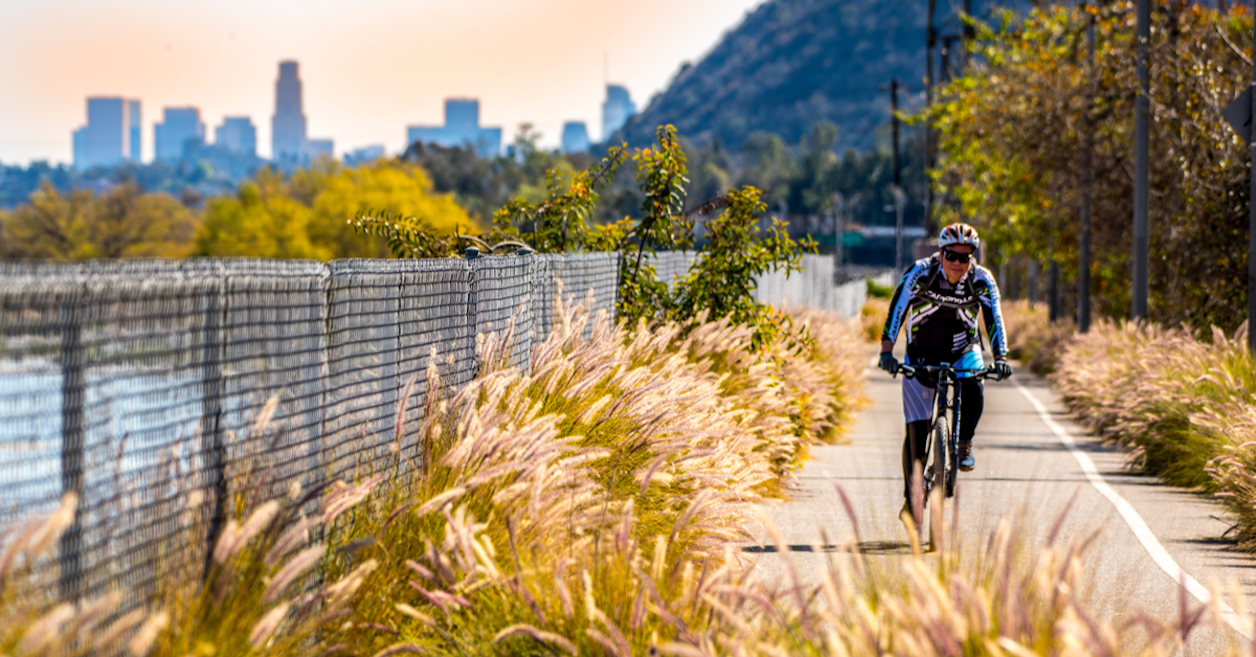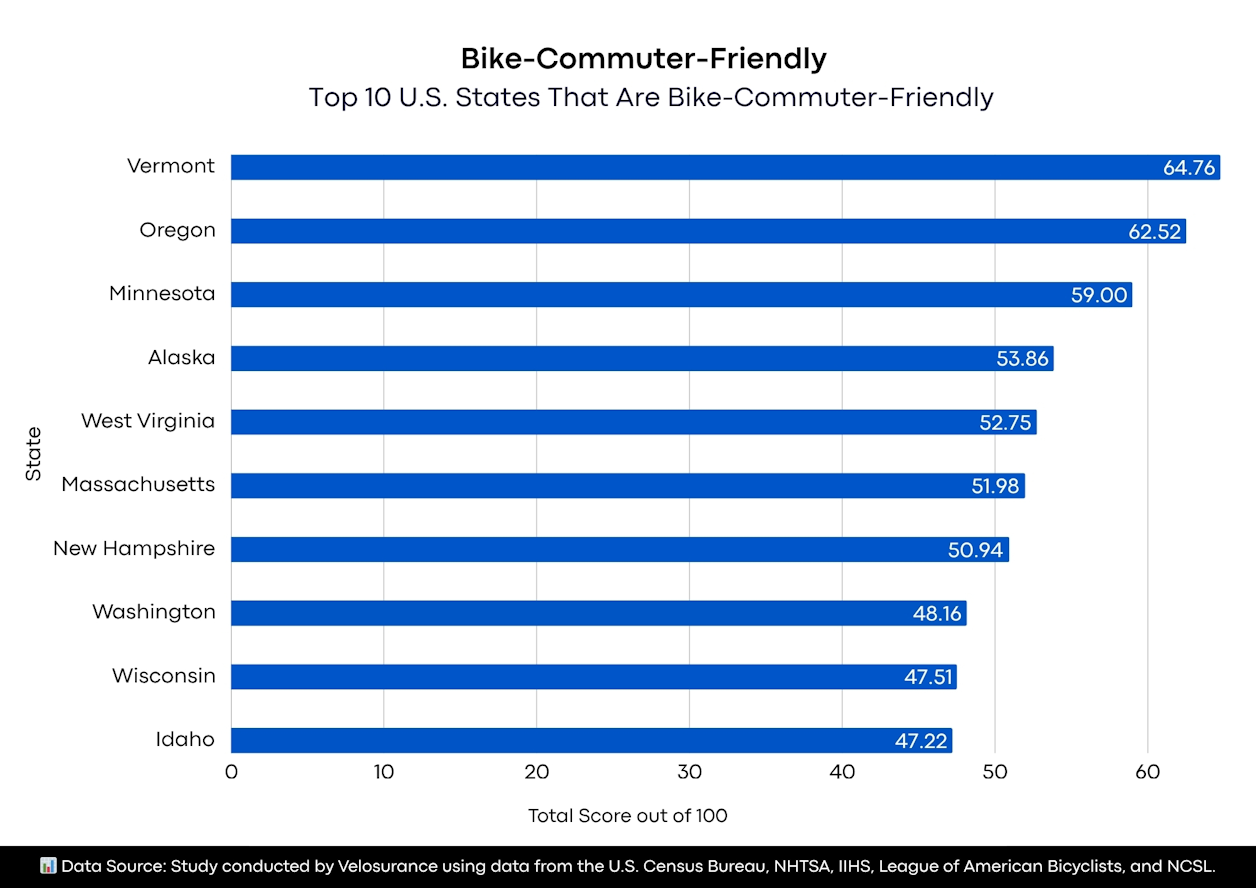The 10 Best U.S. States for Bike Commuters in 2025
While cycling has surged in popularity as a sustainable and health-conscious mode of transportation, the experience of bike commuting varies widely across states, shaped by factors like infrastructure quality, safety regulations, and public investment. Which U.S. States Are Most Bike-Commuter-Friendly? New Study Answers

The Velosurance study analyzed quantitative indicators like miles of bike lanes, traffic fatalities, and federal funding to explore which U.S. states foster the most supportive environments for bicycle commuters. By comparing states’ performance using four key metrics: Ridership Score (30 points), Infrastructure Score (30 points), Road Law & Safety Score (15 points), and FHWA Funding Score (25 points), the study ranks states from most to least favorable for bike commuters on a 100-point scale.
Vermont emerges as the national leader with a bike-commuter-friendly score of 64.76/100. Despite its mountainous landscape, which might seem challenging for cyclists, the Green Mountain State boasts an impressive 2,448 dedicated bike commuters, accounting for 16.4/30 on the Ridership Score. The state’s commitment to safe and sustainable transportation is further evident in its $10.79 per capita in federal funding, one of the highest in the nation, earning Vermont a near-perfect 24.98/25 on the FHWA Funding Score. Vermont also stands out for its picturesque rail trails, which crisscross the state’s charming small towns, helping it to score 13/30 on infrastructure. And with a solid 10/15 on Road Law & Safety, Vermont exemplifies how even a small, rural state can champion bicycle commuting.
Did you know? Vermont’s Stowe Recreation Path is nationally recognized as one of the most scenic bike routes in the country, attracting both tourists and locals alike.
Oregon claims second place with a bike-commuter-friendly score of 62.52/100. Renowned for its cycling culture, the Beaver State has cultivated an exceptional community of 27,180 bicycle commuters (earning a perfect 30/30) among its 2,060,890 total commuters. Additionally, the state demonstrates financial commitment to cycling infrastructure with $8.56 per capita in FHWA funding (scoring 19.81/25) but a modest 3/30 for the overall infrastructure development. The state also ensures reasonable safety measures for cyclists with a 10/15 Road Law & Safety score.
Minnesota ranks third in the study with a bike-commuter-friendly score of 59.00/100. Known as the Land of 10,000 Lakes, Minnesota has cultivated a resilient cycling community of 13,619 bicycle commuters, earning a 10.3/30 Ridership Score. The state’s dedication to supporting bike commuters is reflected in its $5.32 per capita in FHWA funding, resulting in a 12.31/25 score – ample room for future growth. Impressively, Minnesota scores a 22/30 on Infrastructure, thanks to a robust network of bike lanes, off-road trails, and a well-integrated transportation system that caters to both recreational and daily riders. Its perfect score of 15/15 in Road Law & Safety underscores Minnesota’s commitment to protecting cyclists on its roads.
Fun fact: Minneapolis consistently ranks among America’s top cycling cities, thanks in part to the Midtown Greenway, a dedicated 5.5-mile bike highway that sees tens of thousands of riders each year.

Looking at the study, a spokesperson from Velosurance commented:
“The research highlights that states like Vermont, Oregon, and Minnesota are already setting the pace in fostering bike-commuter-friendly environments. These states combine strong ridership rates with supportive infrastructure and robust safety measures, proving that a commitment to cycling can make a real difference.
What’s more, the data suggests that states prioritizing comprehensive bicycle infrastructure, meaningful safety laws, and sustained federal funding consistently create the most welcoming conditions for cyclists. Oregon’s exceptionally high ridership rate (1,318.8 bicycle commuters per 100,000 total commuters) speaks volumes about how a vibrant cycling culture can flourish with the right support.
Taken together, these examples demonstrate that the United States has enormous potential to become a truly bike-friendly nation. By learning from the successes of Vermont, Oregon, and Minnesota, other states can unlock the benefits of reduced traffic congestion, improved public health, and stronger local economies, proving that cycling is not just a lifestyle, but a smart investment in our collective future.”
Alaska secures fourth place with a 53.86/100 bike-commuter-friendly score. While harsh winters and rugged terrain might challenge even the hardiest cyclists, the Last Frontier’s 1,824 bike commuters achieve an 11.5/30 Ridership Score – remarkably resilient considering the state’s size and climate. Alaska shines with the highest per-capita federal funding for cycling at $10.80, earning a perfect 25.00/25. Its 8/30 Infrastructure Score reflects opportunities to expand bike networks, while its 10/15 on Road Law & Safety ensures a reasonable level of protection for cyclists.
Fun fact: Anchorage’s Tony Knowles Coastal Trail is a beloved route for locals and visitors, offering stunning views of Cook Inlet and even the occasional moose sighting.
West Virginia rounds out the top five with a 52.75/100 bike-commuter-friendly score. The Mountain State’s 936 bicycle commuters earn a 2.8/30 Ridership Score – lower than other top contenders, but the state more than makes up for it with an impressive 27/30 on Infrastructure, thanks to its extensive rail trails and scenic greenways that connect communities. West Virginia also secures a 10.39/25 FHWA Funding Score and an impressive 12/15 on Road Law & Safety.
Did you know? The North Bend Rail Trail stretches over 72 miles through West Virginia’s hills and valleys, offering one of the country’s most beautiful long-distance cycling experiences.
Massachusetts ranks sixth with a bike-commuter-friendly score of 51.98/100, followed by New Hampshire ranks seventh with a bike-commuter-friendly score of 50.94/100. Washington ranks eighth with a bike-commuter-friendly score of 48.16/100, followed by Wisconsin and Idaho, taking the ninth and tenth spots with 47.51/100 and 47.22/100, respectively.


